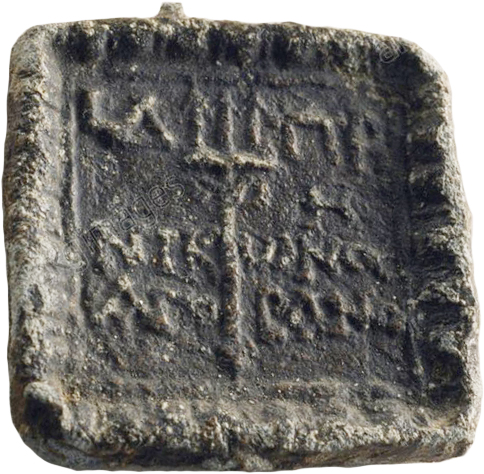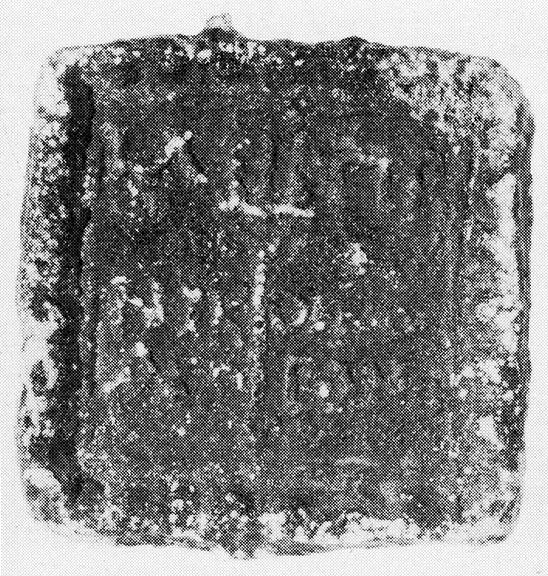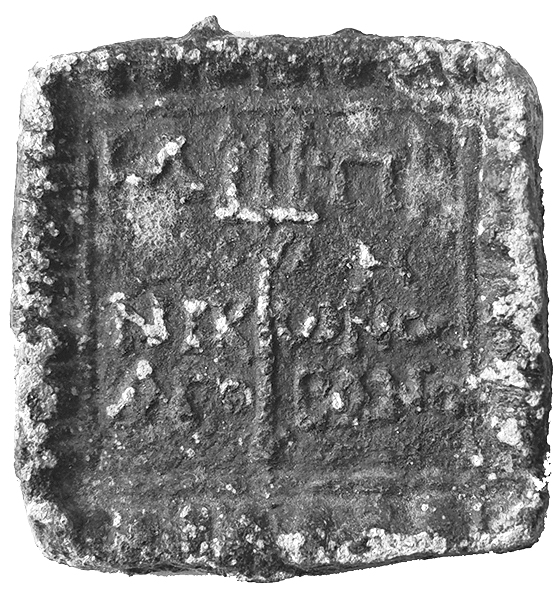
-
Copyright credit: American University of Beirut / Philippe Maillard

-
Copyright credit: Rouvier 1897

-
Copyright credit: Rouvier 1897

-
Copyright credit: Rouvier 1897

-
Copyright credit: Gubel 1986

-
Copyright credit: Antoine Eid / IFPO

-
Copyright credit: Antoine Eid / IFPO

-
Copyright credit: Antoine Eid / IFPO

ARCHAEOLOGICAL DESCRIPTION OF THE WEIGHT
Authority
Nikon, agoranomos (Berytos)
Mint
Berytos
Denomination
1/8 Mina
Material
Lead
Manufacture
Cast
Shape
Square
Length
4.10 cm
Width
4.10 cm
Height
0.40 cm
Metrology
| Mass (g) | Mass (grain) | Date of measurement | Reference | fragmented | cleaned | reference weight |
|---|---|---|---|---|---|---|
| 56.00 | - | - | Seyrig Archives (HS 332, no. 6) | No | No | No |
| 55.80 | - | - | Rouvier 1897 | No | No | Yes |
| 55.80 | - | - | Michon 1907 | No | No | No |
| 56.00 | - | - | Gubel 1986 | No | No | No |
Iconography
| Symbol | Technique | Direction | Position | Number | Synecdoche |
|---|---|---|---|---|---|
| Trident | Relief | ||||
| Egg and dart pattern | Relief |
Wear
Corrosion
Handle
Yes
Suspension hole
Yes
Recarved mould
No
Recarved weight
No
Intentionally destroyed
No
Archaeological description
Rouvier 1897: Ce poids affecte la forme carrée, avec 41 millimètres de côté; il pèse exactement 55 gr. 80. Son épaisseur est de 4 millimètres. La face supérieure présente un carré creux, circonscrit à l’extérieur par une sorte d’encadrement assez riche. Au milieu du champ se trouve un trident, à droite et à gauche duquel on lit en trois lignes : [...]. Dans le champ, à droite, entre la première et la deuxième ligne, on lit de plus la lettre M (indication pondérale).
Seyrig Archives (HS 332, no. 6): Poids carré. 41 mm. Anse au bord supérieur. Bordure saillante, doublée d’un rang d’oves et d’un filet. Poids: 56 g. Trident. L δ–πρ´, | η´, | Νίκ–ωνος | ἀγο–ρανό(μου). Revers (...). Date: 8e mois de l’an 184 de l’ère des Séleucides = 129/128 av. J.-C. Université américaine de Beyrouth, no. 4769.
Gubel 1986: Poids carré, coulé en plomb avec une bordure saillante, ornée de triangles, et légèrement rogné en haut. Le revers est lissé. Cette mutilation supérieure atteste la présence d'un tenon à l'origine. Ces tenons étaient caractéristiques des poids tardifs et ont pu jouer un double rôle: utilitaire, puisqu'il suffisait de les rogner pour ajuster l'instrument à son poids exact, mais aussi néfaste, puisqu'il était loisible à l'usager de les rogner à son tour pour son profit personnel (Seyrig, Poids, p. 73). La plaque porte une inscription grecque de part et d'autre d'un trident droit: ΙΔ ΜΡ | ΜΕ | ΝΙΚ ΟΝΟΥ | ΑΓΟ ΡΟΝ.
Kushnir-Stein 2002: The meaning of the letters in the lower right field is unclear. On the weight of Berytus dated year 184 (129/8 BCE; 55.8 gm.) there is a letter M standing alone in the right field (Rouvier 1897: 369-372). This letter has been interpreted as an indication of weight. However, on the weight of year 161 (152/1 BCE; 267.8 gm.; Babelon and Blanchet 1895: no. 2250) one finds the letters MZ, which seem difficult to reconcile with this interpretation. These letters, as well as those on our weight, may thus have related to administrative matters rather than to the units of weight.
Kushnir-Stein 2005: The weight from Berytus, dated to the year 184 of the Seleucid era (129/8 BCE), has a one-letter sign standing separately in the right field. This was interpreted as a mu (M); however, judging by its form in the documentation published so far - a drawing and a small photograph of the inscribed side (Rouvier 1897: 369; Liban, L'autre rive 1998: 162) - one may say that the letter could in fact be an eta (H), meaning "an eighth." The item now weighs 55.8 g, but it also looks fairly worn and, moreover, has lost the loop at its top; thus, its original weight must have been greater.
Sawaya 2023: Square lead cast weight, suspension loop missing. Dimensions: 41 mm. Mass: 55.80 g. Preservation: good on the obverse and cavities on the reverse. Rouvier 1897a; Rouvier 1897b; Michon 1969, p. 556; Seyrig’s archives: file 332, no. 6; Jidejian 1993, p. 63; Matoïan 1998, p. 162; Augé and Sawaya 2002, p. 331; Kushnir-Stein 2002, p. 228; Kushnir-Stein 2005, p. 17*; Finkielsztejn 2012, p. 142, no. 30; Finkielsztejn 2015, p. 80, 82, and no. 121; Pondera #14910 (visited April 10, 2023). Denomination: eighth mina. Obverse: vertical trident (in center), L Δ–ΠΡ | –H | NIK–ωNOC | ΑΓΟ–ΡΑΝΟ, ‘Year 184, eighth, Nikôn, being agoranomos’, all within a simple square frame surrounded by a raised border with egg-and-dart pattern. Reverse: blank. Agoranomos: Nikôn. Findspot: surroundings of Beirut. Acquisition: Jules Rouvier collection; American University of Beirut collection, no. 4769. Photographic credits: Rouvier 1897a (sketch) and American University of Beirut Museum (photos).
Seyrig Archives (HS 332, no. 6): Poids carré. 41 mm. Anse au bord supérieur. Bordure saillante, doublée d’un rang d’oves et d’un filet. Poids: 56 g. Trident. L δ–πρ´, | η´, | Νίκ–ωνος | ἀγο–ρανό(μου). Revers (...). Date: 8e mois de l’an 184 de l’ère des Séleucides = 129/128 av. J.-C. Université américaine de Beyrouth, no. 4769.
Gubel 1986: Poids carré, coulé en plomb avec une bordure saillante, ornée de triangles, et légèrement rogné en haut. Le revers est lissé. Cette mutilation supérieure atteste la présence d'un tenon à l'origine. Ces tenons étaient caractéristiques des poids tardifs et ont pu jouer un double rôle: utilitaire, puisqu'il suffisait de les rogner pour ajuster l'instrument à son poids exact, mais aussi néfaste, puisqu'il était loisible à l'usager de les rogner à son tour pour son profit personnel (Seyrig, Poids, p. 73). La plaque porte une inscription grecque de part et d'autre d'un trident droit: ΙΔ ΜΡ | ΜΕ | ΝΙΚ ΟΝΟΥ | ΑΓΟ ΡΟΝ.
Kushnir-Stein 2002: The meaning of the letters in the lower right field is unclear. On the weight of Berytus dated year 184 (129/8 BCE; 55.8 gm.) there is a letter M standing alone in the right field (Rouvier 1897: 369-372). This letter has been interpreted as an indication of weight. However, on the weight of year 161 (152/1 BCE; 267.8 gm.; Babelon and Blanchet 1895: no. 2250) one finds the letters MZ, which seem difficult to reconcile with this interpretation. These letters, as well as those on our weight, may thus have related to administrative matters rather than to the units of weight.
Kushnir-Stein 2005: The weight from Berytus, dated to the year 184 of the Seleucid era (129/8 BCE), has a one-letter sign standing separately in the right field. This was interpreted as a mu (M); however, judging by its form in the documentation published so far - a drawing and a small photograph of the inscribed side (Rouvier 1897: 369; Liban, L'autre rive 1998: 162) - one may say that the letter could in fact be an eta (H), meaning "an eighth." The item now weighs 55.8 g, but it also looks fairly worn and, moreover, has lost the loop at its top; thus, its original weight must have been greater.
Sawaya 2023: Square lead cast weight, suspension loop missing. Dimensions: 41 mm. Mass: 55.80 g. Preservation: good on the obverse and cavities on the reverse. Rouvier 1897a; Rouvier 1897b; Michon 1969, p. 556; Seyrig’s archives: file 332, no. 6; Jidejian 1993, p. 63; Matoïan 1998, p. 162; Augé and Sawaya 2002, p. 331; Kushnir-Stein 2002, p. 228; Kushnir-Stein 2005, p. 17*; Finkielsztejn 2012, p. 142, no. 30; Finkielsztejn 2015, p. 80, 82, and no. 121; Pondera #14910 (visited April 10, 2023). Denomination: eighth mina. Obverse: vertical trident (in center), L Δ–ΠΡ | –H | NIK–ωNOC | ΑΓΟ–ΡΑΝΟ, ‘Year 184, eighth, Nikôn, being agoranomos’, all within a simple square frame surrounded by a raised border with egg-and-dart pattern. Reverse: blank. Agoranomos: Nikôn. Findspot: surroundings of Beirut. Acquisition: Jules Rouvier collection; American University of Beirut collection, no. 4769. Photographic credits: Rouvier 1897a (sketch) and American University of Beirut Museum (photos).
Autopsy
No
INSCRIPTION
| Language | Technique | Legend type |
|---|---|---|
| Greek | Relief | Authority, Date, Denomination, Unidentified |
Fac simile
LΔ ΠΡ
Η´
ΝΙΚ ѠΝΟC
AΓOP ANO
Edition
(Ἔτους) δ–πρ´ | (ὄγδοον) | Νίκ–ωνος | ἀγορ–ανό(μου).
L. 2. ηʹ (Kushnir-Stein, Finkielsztejn), Μ (Rouvier).
L. 2. ηʹ (Kushnir-Stein, Finkielsztejn), Μ (Rouvier).
Monogram
ARCHAEOLOGICAL CONTEXT
Findspot (region)
Lebanon: Beyrouth (Bayrūt)
Findspot (site)
Beirut [Berytus / Laodicea / Laodikeia en te Phoinike / Col. Iulia Augusta Felix]
context
Rouvier 1897: J'ai fait dernièrement l'acquisition, pour ma collection particulière , d'un poids antique , en plomb, trouvé dans les environs de Beyrouth (Syrie).
CIRCUMSTANCES OF ACQUISITION
Region
City
Date of first acquisition
circumstances
DATING OF THE WEIGHT
Curatorial Section
GREEK
Time frame
FROM
-129
TO
-128
Comments on Chronology
SE 184 = 129/128 BCE
COLLECTION HISTORY
Collection
| Name | Date of acquisition | Inventory number |
|---|---|---|
| Rouvier Collection | Dec. 31, 1897 | None |
| Archaeological Museum – American University of Beirut | None | 4769 or 5769 (?) |
Bibliography
| Reference | Page/Column | Reference (number) | Plate / Figure | Comment |
|---|---|---|---|---|
| Rouvier 1897a | 369–372 | None | fig. | None |
| Rouvier 1897b | 227–231 | None | fig. | None |
| Michon 1907 | 556, n. 7 | None | None | None |
| Seyrig (archives) | None | HS 332; HS 338 I b | None | None |
| Gubel 1986 | 162 | 138 | None | None |
| Matoïan 1998 | 162 | None | fig. | (non vidi) |
| Augé and Sawaya 2002 | 331 | None | None | None |
| Kushnir-Stein 2002a | 228 | None | None | None |
| Kushnir-Stein 2005 | 17* | None | None | None |
| SEG 55 | None | 1629, 2 | None | (non vidi) |
| Finkielsztejn 2012 | 142 | 30 | None | None |
| Gatier 2014 | 153–154 | None | None | None |
| Finkielsztejn 2015 | 80–82 | 121 | None | None |
| IGLS VIII/1 | None | None | None | None |
| Sawaya 2023 | 85–86, 110 | 12 | fig. 12 | None |
VARIA